 Image search results - "shopping" Image search results - "shopping" |

Shopping street near Takaoka Station
|
|
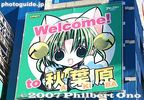
Welcome to Akihabara! (Or Akiba for short.) Japan and Tokyo's largest cluster of electronics shops.
|
|
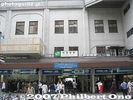
JR Akihabara Station
|
|

Always a crowd in front of JR Akihabara Station
|
|

Here's one reason for the crowd...
|
|

Shopping street
|
|

And another one. Young pretty/cute girls in costume pass out flyers, but end up being street models for amateur photographers who have no girlfriends to shoot.
|
|

They are happy to pose...
|
|

The maid costume is all the rage in Japan, for several years now.
|
|

Santa suit appears in Dec.
|
|

Coming out of Akihabara Station
|
|
|

Main drag of Akihabara
|
|
|

Train bridge
|
|

Train bridge
|
|

Train bridge to Akihabara Station
|
|

Under the train bridge is "Radio Center," a cluster of many little stalls selling electronic parts.
|
|

Inside Radio Center, where many teens (and future electronics engineers) bought their parts to build their first radio or motor or whatever.
|
|

One stall in Radio Center.
|
|

Other side of Akihabara Station
|
|

Going down the main drag (Chuo-dori) of Akihabara.
|
|

Large and small electronics shops line the main drag on both sides.
|
|

In autumn, we see fall leaves, a most appropriate sight in Akihabara because "Akihabara" means "Autumn leaves field."
|
|
|
|

Shopping street near Ontakesan Station
|
|

Akihabara has undergone a few transformations over the decades. From general electronics, to computers, and now anime and video games.
|
|

Akihabara is also undergoing a major physical transformation with the new Tsukuba Express train line, a revamped Akihabara Station, Yodobashi, and several skyscrapers.
|
|
|
|

Akiba Square in the new Akihabara UDX (Crossfield) building next to Akihabara Station.
|
|

Entrance to Sugamo Jizo-dori shopping street 巣鴨地蔵通り商店街
|
|

Sugamo Jizo-dori shopping street 巣鴨地蔵通り商店街「おばあちゃんの原宿」
|
|

Former site of Mitsubishi Bank to be transformed soon. This is also the intersection where Tomohiro Kato ran a truck through to hit and kill three pedestrians and went on a street rampage with a knife killing four others on June 8, 2008.
|
|

The clothing shops are geared for elderly women. Sugamo is the fashion capital for elderly women. 「おばあちゃんの原宿」
|
|

Don Quixote in the huge building which used to be Minami Denki.
|
|

Nakasendo road marker.
|
|

Inside Don Quixote, Akihabara store
|
|

Most of the clothing items are price low, around 1,000 yen which might be affordable by people living on social security.
|
|

More fall leaves in Akihabara
|
|

Hat shop
|
|

On Sundays, the main drag is closed off to vehicular traffic, allowing us pedestrians to walk on the road.
|
|

Sugamo Jizo-dori shopping street 巣鴨地蔵通り商店街
|
|

It's also when some street performers start to sing.
|
|

Here's a cutie trying to gather attention.
|
|

Another one is happy to sing while a horde of amateur photographers click away.
|
|

They sing on the street to advertise something, usually a night club where they appear.
|
|

The ever-popular maid outfit.
|
|
|

Maids attract much attention so they are used as living billboards for stores and whatever needs to be advertised in Akihabara.
|
|

Cosplayer teenager posing on the road.
|
|

The problem is that the police patrol the main drag to expel these street performers. It is not allowed. It would be the Japanese police to try and kill Japan's street culture.
|
|

Developed area next to Akihabara Station. Once upon a time, this used to be a wholesale area for fruit. Then an outdoor basketball/skateboard court.
|
|
|
|

JR Akihabara Station's new Central entrance faces Yodobashi camera shop.
|
|

JR Akihabara Station's new Central entrance (Yodobashi on the left)
|
|

Inside JR Akihabara Station's new Central entrance. Very nice, very spacious.
|
|

Kōgan-ji Temple (高岩寺)
|
|

Bus stop near JR Akihabara Station's new Central entrance
|
|

Gate to Koganji temple, a famous spot along the shopping street.
|
|

Yodobashi-Akiba, the largest store in Akihabara. Major camera, computer, and electronics store. A favorite store for photographers in Japan.
|
|

Koganji temple. The temple's popular name is "Togenuki Jizo-son." It sells magic paper called osugata which supposed to remove a thorn or splinter from your skin. Affix it to the thorn and it will be extracted. とげぬき地蔵尊
|
|

Crosswalk to Yodobashi
|
|

Togenuki means thorn-extracting. Koganji temple incense burner
|
|

Street singer in front of JR Akihabara Station's new Central entrance
|
|

Koganji temple Hondo hall. This is a Zen temple belonging to the Soto-shu school. The temple was founded in 1596 and moved to Sugamo in 1891.
|
|

Street singer in front of JR Akihabara Station's new Central entrance. A cute face and miniskirt really help to gather a crowd.
|
|

Inside Koganji temple Hondo. The temple houses the Togenuki Jizo statue which is not visible to the public.
|
|

Her setup is simple. A portable and battery-powered amplifier connected to a microphone. The amp is on a luggage cart. When the police comes, she can pack up and leave within 5 sec.
|
|

Grounds of Koganji temple as seen from the Hondo hall.
|
|

These girls usually have a lookout man who watches out for the cops. As soon as he sees one coming, he runs up to her and gives the "Outta here" signal. They're gone before the police can even see them. It's a constant cat and mouse game
|
|

People line up to wash the famous Kannon statue. The line gets longer on weekends.
|
|

She says that it was her first "Street live performance" (rojo raibu).
|
|

People in line for the Arai (Washable) Kannon statue. Anybody can line up and scrub the statue. No charge.
|
|
|

Arai Kannon statue. Wash the part of the body to cure the corresponding part of your own body. 洗い観音
|
|

Street performer
|
|

They used to have a tawashi brush to wash the statue, but that wore out the statue. So the replacement statue is now washed/rubbed with a towel instead.
|
|

Street performer near Yodobashi-Akiba, the largest store in Akihabara.
|
|

Jizo statue
|
|

A miniskirted pair
|
|

Jizo statue
|
|

Sign says "No street performances allowed."
|
|

People relax in front of the temple.
|
|

Yodobashi-Akiba, the largest store in Akihabara. Major camera, computer, and electronics store.
|
|
|
|
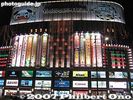
Yodobashi-Akiba at night
|
|

The shopping street is quite long, going all the way to Nishi-Sugamo on the Mita subway line.
|
|
|

The famous red underwear. Supposed to keep you warmer. For men and women.
|
|

Umbrella shop
|
|
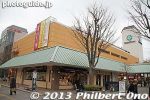
Mori Town shopping mall on the north side of JR Akishima Statin.
|
|
|
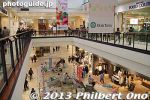
Inside Mori Town shopping mall in Akishima, Tokyo.
|
|
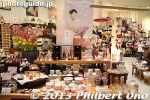
Hina Matsuri sale
|
|
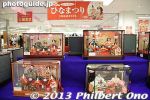
I visted Akishima on March 3, 2013, Girl's Day or Hina Matsuri Doll Festival. Ito Yokado was selling hina dolls for 70,000 to 100,000 yen.
|
|
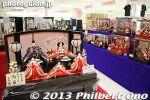
Hina matsuri dolls for sale.
|
|
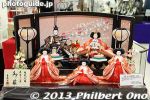
100,000 yen for hina dolls.
|
|
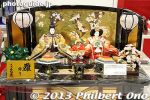
100,000 yen for hina dolls.
|
|
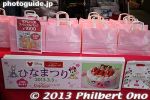
Cake maker
|
|
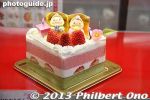
Hina matsuri cake
|
|
|
|

After passing through the Kaminarimon Gate, this is what you see: Nakamise shopping arcade. When it rains, a canopy is put up.
|
|

Nakamise-dori souvenir arcade. One of Japan's most popular and crowded tourist arcades.
|
|

In spring, a cherry blossom motif is put up.
|
|

At the end of the year and New Year's, auspicious red and white and New Year's decorations are put up.
|
|

Nakamise sells all kinds of Japanese things. Originally, they catered to religious pilgrims. Now it's mostly tourists.
|
|
|

Kimono shop
|
|

Kimono shop
|
|

Traditional footwear
|
|

Paper umbrellas
|
|

Trinkets
|
|

Small Kannon statues for 25,000 yen.
|
|

The airport has a huge shopping area full of gift shops.
|
|

G8 Hokkaido Toyako Summit merchandise. They all seem to be unofficial goods. They don't bear the official logo.
|
|

Michinoeki Biwako Ohashi Kome Plaza, a shopping place for local produce. 道の駅びわ湖大橋米プラザ
|
|

Inside Biwako Ohashi Kome Plaza. "Kome" means rice. On the first floor they sell local rice and produce.
|
|

Biwako Ohashi Kome Plaza facing the lake. It also has a lookout deck on the 2nd floor.
|
|

Kichijoji Sunroad, Kichijoji's main shopping arcade. サンロード
|
|
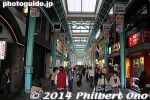
Kichijoji Sunroad サンロード
|
|

Kichijoji Sunroad サンロード
|
|

Motomachi-dori
|
|
|
|

A long line of people waiting to buy croquette at a well-known shop.
|
|
|
|
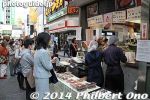
Start of the line, what they are waiting for.
|
|

What people are waiting in line for. Didn't buy the famous croqeutte, but bought some meatballs and they were good. Still warm.
|
|

More shopping. Kichijoji is like one big shopping area, anchored by three major dept. stores.
|
|
|
|
|
|
|
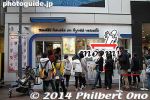
Moonmin shop
|
|
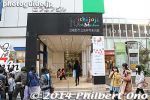
Kichijoji Art Museum
|
|
|
|
|

Yodobashi-Kichijoji megastore for cameras and electronics. One of the largest stores in Tokyo. This used to be Kintetsu Dept. Store.
|
|
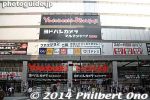
Yodobashi-Kichijoji megastore for cameras and electronics.
|
|

South side of Kichijoji Station
|
|

Park Road shopping arcade on south side of Kichijoji Station.
|
|

Marui Dept. Store (not zero-one zero-one or oioi).
|
|

Inokashira-dori
|
|

Yakitori restaurant in one of the narrow alleys in front of Kichijoji Station.
|
|

Yakitori
|
|

Yakitori
|
|
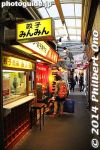
Gyoza shop in Kichijoji
|
|
|
|

The finale was a parade through the Sun Road arcade at 4:30 pm, led by this truck with musicians and dacners.
|
|

Dancer on truck
|
|

One mikoshi was in the parade through the arcade.
|
|

Mikoshi in Kichijoji Sun Road shopping arcade
|
|

Mikoshi in Kichijoji Sun Road shopping arcade, Kichijoji Autumn Festival
|
|
|

Mikoshi in Kichijoji Sun Road shopping arcade, Kichijoji Autumn Festival
|
|

Other mikoshi heading back home. This one passed by Yodobashi Kichijoji.
|
|

What goes in, must come out. This is the other end of Sun Road shopping arcade on Itsukaichi Kaido road.
|
|
|
|

Mikoshi coming out of Sun Road in Kichijoji
|
|

Mikoshi in Sun Road in Kichijoji
|
|
|

They are now on Itsukaichi Kaido road, heading toward Musashino Hachimangu Shrine.
|
|
|
|
|

Riverside Mall shopping street in Izumi
|
|

Riverside Mall shopping street in Izumi
|
|
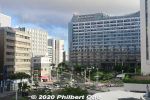
In central Naha, Kokusai-dori is the city's main drag of shops and restaurants. Mostly for tourists. The nearest rail stations are Kencho-mae and Makishi Stations on the Yui Rail. Large building on the right is the Okinawa Prefectural capitol.
|
|
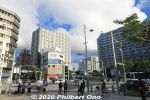
Intersection in front of Kokusai-dori.
|
|
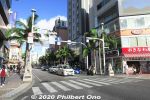
Entrance to Kokusai-dori.
|
|
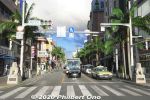
Entrance to Kokusai-dori is flanked by two shisa guardian lion-dogs.
|
|
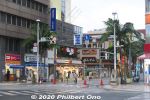
Entrance to Kokusai-dori.
|
|
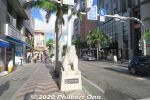
Shisa guardian lion-dog.
|
|
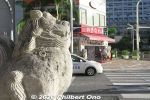
Shisa guardian lion-dog at the entrance of Kokusai-dori.
|
|
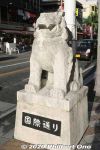
Shisa guardian lion-dog at the entrance of Kokusai-dori.
|
|
|
|
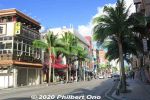
In central Naha, Kokusai-dori (国際通り), main drag of tourist shops and restaurants. Lined with palm trees.
|
|
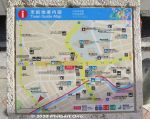
Map of Kokusai-dori.
|
|
|

Gift shop modeled after Shuri Castle.
|
|
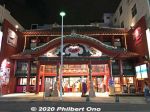
Gift shop modeled after Shuri Castle.
|
|
|
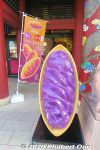
Beni-imo tarts are Okinawa's most famous confection and omiyage gift. Made of Okinawan sweet potato (purple yam) in a boat-like crust.
|
|
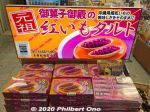
Beni-imo tart is sold everywhere in Okinawa. Like macadamia nut chocolates in Hawaii, there are many Beni-imo tart brands in Okinawa. I'm told the most famous brand is Okashi Goten (御菓子御殿), the confection's inventor.
|
|
|
|
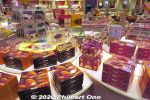
Inside the Okashi Goten (御菓子御殿) tart shop.
|
|
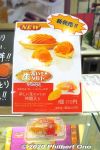
This new tart flavor is also good.
|
|
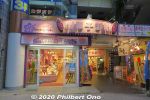
Beni-imo tart shop.
|
|

Habu liquor or habu-shu with a dead habu snake inside. Made with awamori or brandy. The extract from the snake supposed to be good for you. The snake's venom is somehow neutralized by the alcohol, so it's not poisonous when you drink it.Never tried it. What do people do with the snake after drinking the sake? Would a bird of prey eat an alcohol-soaked snake? ハブ酒
|
|
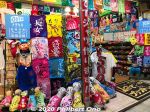
Lots of T-shirt shops on Kokusai-dori, but most are not made in Okinawa.
|
|
|
|
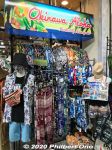
"Okinawa Aloha," apparently Hawaii is idolized in Okinawa.
|
|
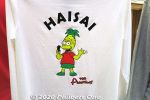
Haisai T-shirt. "Haisai" is a "hello" greeting for men.
|
|
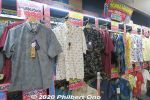
Kariyushi shirts, Okinawan-style Aloha shirts. Make sure the shirt is made in Okinawa. Cheaper ones are made elsewhere in Asia.
|
|
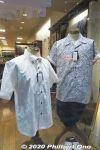
Kariyushi shirts, Okinawan-style Aloha shirts.
|
|
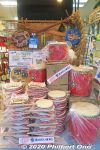
Taiko drums for sale on Kokusai-dori.
|
|
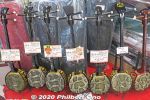
Sanshin for sale on Kokusai-dori.
|
|

Okinawan dolls for sale on Kokusai-dori.
|
|
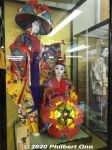
Okinawan dolls for sale on Kokusai-dori.
|
|
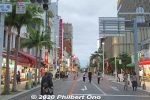
On Sundays, Kokusai-dori is closed to traffic.
|
|
|
|

Haisai Okinawa Building on Kokusai-dori. ハイサイおきなわビル
|
|
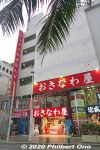
Haisai Okinawa Building on Kokusai-dori. ハイサイおきなわビル
|
|
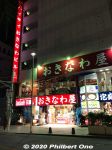
Haisai Okinawa Building on Kokusai-dori. ハイサイおきなわビル
|
|

Haisai Okinawa Building entrance on Kokusai-dori. ハイサイおきなわビル
|
|
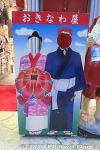
Haisai Okinawa Building on Kokusai-dori. ハイサイおきなわビル
|
|
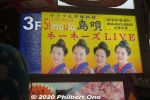
Haisai Okinawa Building on Kokusai-dori is where the Nenes/Nenez perform at Live House Shima-uta on the 3rd floor.
|
|
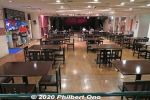
Live House Shima-uta. About 50 people can fit into the club. Entirely non-smoking. Reservations recommended.
|
|
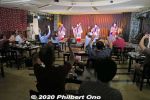
Famous Nenes/Nenez perform at Live House Shima-uta on most nights. Third floor of Haisai Okinawa Building on Kokusai-dori.http://livehousesimauta.com/
|
|

Doesn't feel like I'm in Okinawa until I see and hear Okinawan music. Well-known Okinawan female quartet since the 1990s.They played their original hit songs like "Kogane no Hana" (黄金の花), Okinawan folk favorites like "Tinsagu no Hana" (てぃんさぐの花) and tracks from their latest CD.
|
|
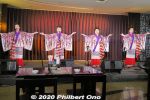
The show is from 7 pm to 10 pm when they play three sets (two intermissions) for a cover charge of only ¥2,300 (as of Nov. 2020). Food and drink are extra.http://livehousesimauta.com/
|
|

The show is great with colorful costumes and singing. There's also audience participation. Not allowed to go up and dance though.
|
|

The Nenes have been around since the 1990s, made famous when Sakamoto Ryuichi featured them in his Okinawan CDs and took them on a concert tour.
|
|
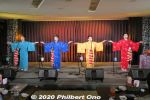
They've lasted this long thanks to occasional personnel changes. The current members are the sixth incarnation of the group.
|
|

In recent years, they've been spelling their name in English as "Nenez." However, the original spelling is "Nenes" which is how I still spell their name. Not to be confused with the Hawaiian goose. "Nene" means "sister" in Okinawan, equivalent to "ne-chan" in Japanese.
|
|
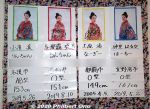
From left to right, the current Nenes/Nenez are Kohama Rin (小濱凜), Yonaha Ruon (与那覇琉音), Uehara Nagisa (上原渚), and Nakazato Haruhi (仲里はるひ). ネーネーズMost are in their 20s, and two of them have grandmothers who were the original Nenes from the early 1990s. Amazing! (As of Nov. 2020.)
|
|
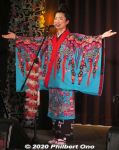
Kohama Rin (小濱凜) wears a bingata kimono. 紅型 They wear different Okinawan costumes for each set. Colorful eye candy. Wish they also explained the Okinawan design of their gorgeous kimono. Crowd-pleasing entertainment.
|
|

She plays the sanshin (三線), another icon of Okinawa. The three-stringed sanshin came to Okinawa (Ryukyu Kingdom) from China in the 16th century. It later evolved into the shamisen on mainland Japan.
|
|

The sanshin is Okinawa's main musical instrument. What the sanshin is to Okinawa is what the ʻukulele is to Hawaii. Famous for the snakeskin (python) covered body, but cheaper sanshin might have fake snakeskin which is easier to care for.
|
|

Still photography is allowed, but no videos.
|
|

Rin also plays the ʻukulele as a hobby.
|
|
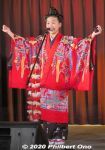
Yonaha Ruon (与那覇琉音) is the youngest member and plays this Okinawan instrument called the "sanba" (三板). It's three small pieces of wood strung together to make clacking sounds. Love the sanba.
|
|
|
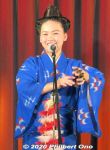
Okinawan instrument called the "sanba" (三板). It's three small pieces of wood strung together to make clacking sounds.
|
|
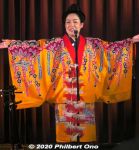
Uehara Nagisa (上原渚) is the oldest and current Nenes leader. Member since 2004.
|
|
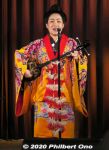
The sanshin is a modest instrument, used to complement the singing. Okinawan folk songs focus on the singing, not the instruments. This is opposite from the Tsugaru-jamisen (shamisen) in Aomori Prefecture which uses the showy jamisen as the main focus with long jamisen instrumentals.
|
|
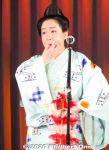
Uehara Nagisa (上原渚) plays another common Okinawan musical instrument: the finger whistle (yubi-bue 指笛).
|
|
|
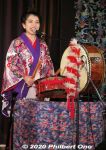
Nakazato Haruhi (仲里はるひ) plays many instruments, centering on the sanshin and taiko drums.
|
|

Taiko drums is also big in Okinawan music.
|
|
|
|
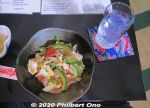
The food and drinks at Live House Shima-uta are good. This is goya-chanpuru (¥700), my Okinawan favorite. You can eat during the two intermissions.
|
|

Live House Shima-uta menu. Reasonable prices. Official website usually has a coupon for a free side dish.
|
|
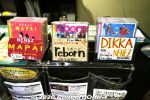
The club had their CDs on sale, but they weren't autographed.
|
|
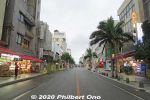
Pedestrain paradise on Kokusai-dori on Sunday.
|
|
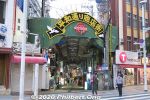
Heiwa-dori shopping arcade, a side street off Kokusai-dori.
|
|
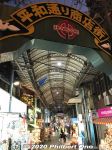
Heiwa-dori shopping arcade
|
|
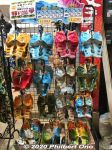
Rubber slippers
|
|
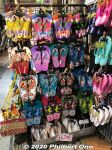
Rubber slippers
|
|
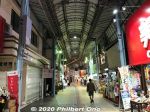
Not so many people during a pandemic.
|
|
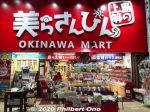
Okinawa Mart
|
|
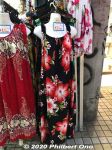
Most cheap clothing not made in Okinawa. The cheap ones especially.
|
|
|

She's selling goya (bitter melon) juice. I tried it.
|
|

Colorful fish in the old Makishi Public Market where you could pick the fish to be cooked for your meal.
|
|
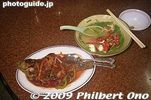
My lunch.
|
|

Pickled vegetables.
|
|
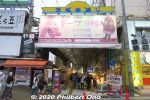
Ichiba-Hondori shopping arcade.
|
|
|
|